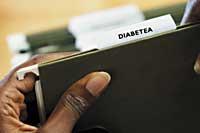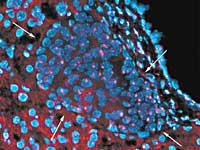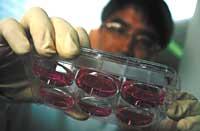Analysis of Diabetes
Farmazian doktorea. Biofarmazia, Farmakozinetika eta Farmazia-teknologiako irakasle kolaboratzailea
Farmazia Fakultatea UPV-EHU, Vitoria-Gasteiz

According to experts, diabetes is a ‘silent killer’, since the disease does not produce symptoms for a long time and is often known when any other alteration that threatens the life of the patient appears. These alterations include problems of the blood vessels, diabetic retinopathies, alterations of the heart and others.
Given the severity of diabetes, many scientists look for more effective treatments. In this article we review the most outstanding advances that have been made in recent months: some are basic, others have still been tested only in animals and others, fortunately, have been properly analyzed in humans.
Transplant of Are islands and stem cells

Between 1990 and 2000, the use of the islands in the treatment area of diabetes was approved, some special insulin-producing cells. For this purpose, the islands of a healthy volunteer or even a dead person were necessary. Initially the effectiveness of the sand transplant was very low, only 8%. However, in 2000, coinciding with the implementation of the famous Edmonton protocol, the validity and potentiality of the islands increased.
This protocol, designed in Canada, significantly improved the distribution and conservation of the islands, avoiding the use of corticosteroids as immune response inhibitors. And the use of tacrolimus and sirolimus increased the efficacy of treatment by up to 80%. However, there was still a serious problem to solve: the shortage of areas.
It must be taken into account that for a single adequate transplant, cells from three or four areas were needed. With these limits, in Spain, for example, 200 transplants per year could be performed and every year between 2,000 and 3,000 new cases are detected. The borders were, therefore, great.

Professor Sutherland and his team, who works at the University of Minneapolis, have been able to partly solve this problem. At once they have managed to obtain all the cells necessary for a transplant. In addition, a year after cell transplantation, these patients should not take insulin every day and their quality of life has improved substantially.
The secret of these spectacular results lies in the cultivation and maintenance of cells. In fact, Sutherland oxygenated the cells well and gave them to patients in 2 or 3 days. According to the professor, although the transplant of everything is even more effective than the cell transplant, the technique developed by him is also very safe, since it is enough to use only one.
On the other hand, we must not forget the interesting advances that have recently been made with stem cells. In recent months, in Spain and throughout Europe, the use of this type of research is understood and promoted. As a result, more and more research groups dare to delve into this new scientific field. For example, according to the latest research by the prestigious Bernat Soria, it will soon be possible to separate the cells that secrete insulin from the blood of the patient.
Gene therapy

Treatment of diabetes can take different views. The efforts of some groups focus on the prevention of alterations that can lead to diabetes. Among other alterations, it highlights diabetic retinopathy, a serious frequent problem. This ocular agitation is the main cause of blindness in Spain.
For this reason, in 1990 the team of Fatima Bosch (Autonomous University of Barcelona) began to seek treatments against diabetic retinopathy that could be derived from diabetes. The final results of the group show that the levels of IGF-1 measured in the retinas of the patients, a growth factor similar to insulin, are relatively high compared to the levels of volunteering.
For a better analysis of the functions of this IGF-1 factor, the Catalan team created GM rats expressing too many IGF-1 factors. And these rats, although they are not diabetic, developed retinopathies as if they were diabetic. Once demonstrated the importance of IGF-1, this factor is in the production phase of viral vectors that secrete the block or molecules that can inhibit. Professor Bosch believes that gene therapy can become an effective strategy to treat alterations that occur in diabetic patients.
Basic research

The search for effective high-security drugs requires a basic and deep research. This annoying task allows experts not only to better understand the causes of diseases, but also to develop new therapeutic pathways. For example, an American group discovers why insulin resistance is caused by the body.
So far, experts did not know why diabetes was produced, especially did not understand the relationship between overweight and insulin resistance. The latest research has found that one of those responsible for insulin resistance is the transcription factor Kappa B.
This discovery can have important consequences, as some usual analgesics, with a component of salicylate, can be useful for treating diabetes. It is still early to recommend the administration of these drugs, but within a few years it would not be rare for doctors to prescribe them.
Types of DiabetesThere are two types of diabetes. Type I diabetes is of genetic origin and appears mainly in children and young people. On the contrary, type II diabetes is related to age in approximately 90% of cases, when the area, the insulin-producing organ, begins to lose functionality. |





